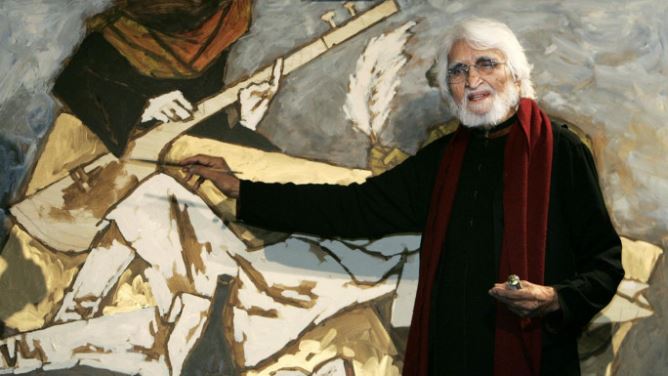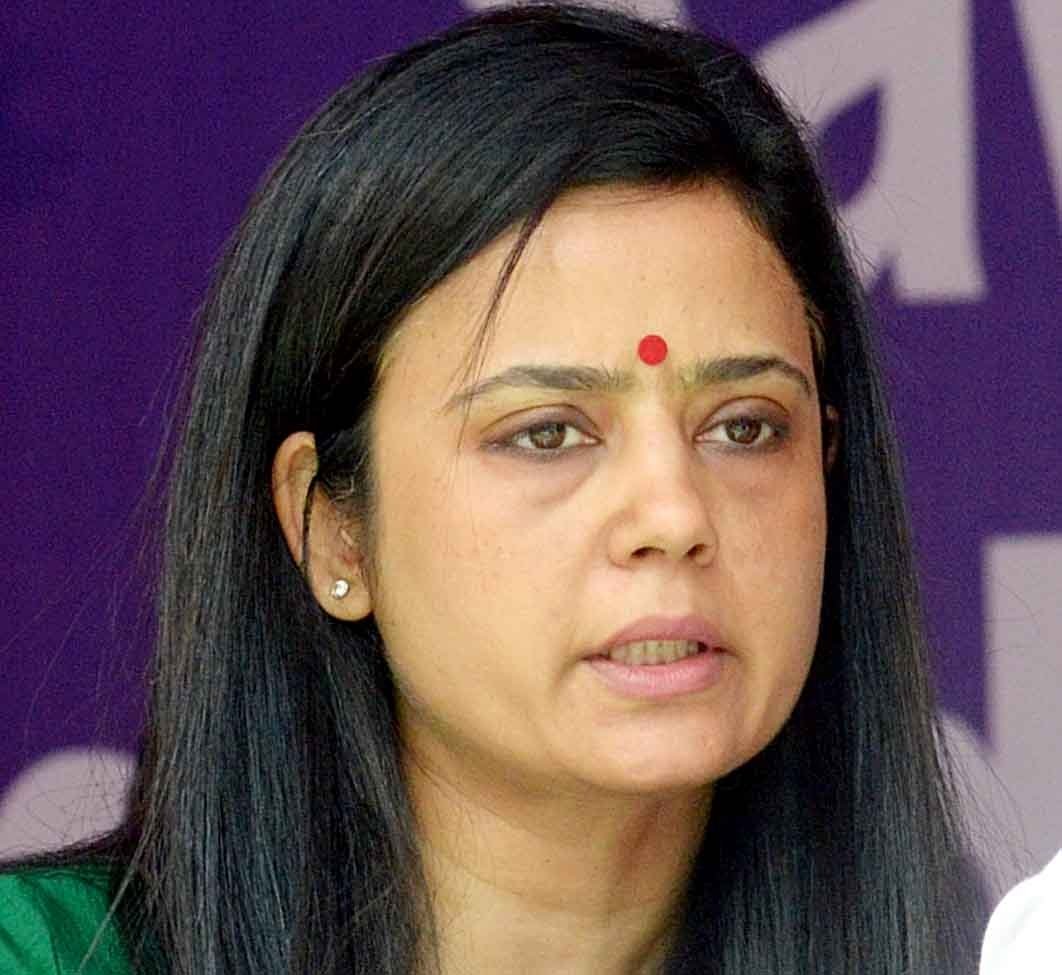
This is not about Sharma, Manimekalai or Moitra; neither is it about the BJP, TMC or any other political party. It is about today’s India, losing its secular identity with faiths crossing paths.
Maqbool Fida Husain, the celebrated artist, who spent his sunset years away from his home in India, liberally used the freedom of expression tool, to bring alive the gods on canvas. Except there were only Hindu deities that were on his radar. Worse still, he painted them in the nude: Goddess Saraswati in black and white and Parvati as Aparn, or without leaves among others.
Hell broke loose when the barefoot painter dared to paint India, inflamed in red. Once again in the nude, this was among Husain’s most controversial works: a weeping woman portrayed as India, titled Bharat Mata.
For record, Husain claimed that he had never given that title, even as right-wing organizations like VHP and RSS were baying for his blood. There was a reward on his head and he was forced into exile in 2006.
Till his death in the summer of 2011, Husain longed to return to India even if it was, to quote his friend “for half an hour for a cup of chai ”. He never could: either for his khus chai at the Irani café in Mumbai or the jalebi at the Cricket Club.
During one of his conversations, Husain had reportedly spoken about the age-old tradition of painting and sculpting gods and goddesses. His argument: Hindus were tolerant enough to understand the art.
“Why don’t you paint Islamic history” he was once asked by some Muslims from Hyderabad: “Do you” he had then shot back, “have the tolerance that Hindus have?”.
Irrespective, Husain toyed with Hindu gods and goddesses despite protests and legal cases being slapped against him. A Hindu organization went as far as calling him “anti-national and perverse artist”.
One shudders to think how things would have panned out were Husain alive today?
For starters, his Muslim identity would have come handy for the rabid. They would have demanded his head for irreverence, blasphemy and sacrilege, conveniently forgetting that Husain is perhaps the only artist to have painted the Ramayana and Mahabharata in over a hundred canvases.
 Pitch the past with the present: a Nupur Sharma or a Mahua Moitra belittling the gods. They may not have a brush in hand but they sure are wielding a hate weapon which is irreparably damaging the social fabric of what once was secular India.
Pitch the past with the present: a Nupur Sharma or a Mahua Moitra belittling the gods. They may not have a brush in hand but they sure are wielding a hate weapon which is irreparably damaging the social fabric of what once was secular India.
In the present context, secularism is a thing of the past. However, over-exploited and misused the term may have been, it did act as an adhesive to a country called India: a country that is fast becoming Hindustan. The fact that this sentiment draws its strength from the powers that rule, gives it legitimacy and validity.
If BJP’s Sharma is in the line of fire for insulting the Prophet, Mahua Moitra of TMC, has supported a smoking Kali. Both Gods from different genres: Islam and Hinduism respectively.
Nupur Sharma raised a storm with what has popularly become to be known as the Prophet remark.
It started on a television debate and spilled to the streets.
Till the storm erupted , Sharma was a familiar face on Indian news channels, vociferously defending the BJP as its Party Spokesperson.
In May this year, Sharma made adverse remarks against Prophet Muhammad which sparked a massive outrage, both nationally and globally. She had apparently lost her cool when another panelist, a Muslim, had mocked Hindu God Shiva.
The clip went viral and Sharma’s head was on the chopping block.
If Muslims in India took to the streets, the Arab world slammed India over the comments. Some went as far as pulling out Indian products from their supermarkets.
Sharma’s suspension from the Party did little to placate Islamic nations. Or the fact that she withdrew her remarks unconditionally.
On its part, the BJP distanced itself from the comments stating that these were “views of fringe elements”.
The definitions were decidedly skewed because to disown an official spokesperson and dub her as fringe is too much to digest.
Back at home, riots broke out across several parts of India. Protestors hit the streets and incidents of vandalism, stone-pelting and police vehicles being set on fire, were reported from different states.
Apart from Jharkhand, West Bengal, Bihar and Uttar Pradesh, incidents of violence were reported from the national capital of Delhi. If Jama Masjid was the hub in Delhi, in Maharashtra, women led the protests.
When Vishwa Hindu Parishad (VHP) jumped to Sharma’s defence stating that the matter would be decided by the Court, little did it know that it was walking on fire.
It had not bargained for the caustic observations by the apex Court wherein it stated that Sharma’s remarks were made for “cheap publicity, a political agenda or for some nefarious activities”.
Castigating her, the Court observed that Sharma had a loose tongue; had set the entire country on fire, threatened the security of the nation and is single handedly responsible for what is happening across the country.
Harsh words for someone seeking justice from the same Courts that chose to damn her.
If the Court’s observations put Sharma in the dock, there was also an outpouring of support for her.
As many as 117 retired judges and civil servants shot off a letter, dubbing the comments to be “unprecedented”. The “Lakshman Rekha”, they added, “had been surpassed”.
Till the Courts stepped in, Sharma was the villain of the piece. There were only a handful who shed tears, pointing a finger at the BJP for making her a sacrificial goat.
Politicians, too, were quick to jump in.
Congress leader Rahul Gandhi squarely blamed Prime Minister Narendra Modi, Union Home Minister Amit Shah and company for vitiating the atmosphere in the country and creating an environment of “anger and hatred”.
Sitaram Yechury of CPI (M) said it was an “indictment of the divisiveness BJP promotes and the hate its leaders and trolls consistently fan”.
Meanwhile, Sharma fought a lone battle with rabble rousers demanding her head.
However, within the BJP, there were misgivings about Sharma being made a scapegoat.
Apart from the BJP succumbing to international pressure and acting against one of its own, there was a worry about the messaging.
This has two dimensions: on the one hand, it was about the morale of the rank and file. The Party cracking the whip on Sharma for doing her job has not gone down well in some sections.
Worse still, it has shown the BJP as a Party willing to compromise when the going gets tough. That the BJP succumbed under international pressure is a given. The way things have panned out, it is unlikely that the second rung will willingly stick its neck out.
The other dimension, and perhaps the more important one, is political.
he BJP bending over backwards to be at someone’s bidding, read Muslims, may not augur well for the saffron Party.
Even if backlash is a strong word to use in this context, BJP’s core vote bank, namely the Hindus, are likely to feel let down by a Party that they have backed to the hilt. At least till now. Of course with the Party being on a high, these are minor storms that it can well battle.
The dust has yet to settle on the Prophet versus Shiva controversy, as it were, when another demon raised its head. And this time around it is goddess Kali, known for slaying the devil.
It all started with a movie poster shared by filmmaker Leena Manimekalai wherein a woman depicted as goddess Kali is seen smoking a cigarette. She is also shown wielding the trident and a sickle as well as carrying the LGBTQ+ community flag: “My Kaali is queer. She is a free spirit. She spits at the patriarchy”, announced the controversial filmmaker.
A section of the Hindu community was up in arms seeking legal action against Toronto based, Manimekalai.
A political dimension to the entire controversy was given by Mahua Moitra, an MP and a vocal member of the Trinamool Congress.
 Moitra stirred the hornet’s nest by saying that Kaali is a “meat eating and alcohol accepting goddess”.
Moitra stirred the hornet’s nest by saying that Kaali is a “meat eating and alcohol accepting goddess”.
Moitra is partially right because goddess Kaali’s worship necessitates bali or sacrifice. How the smoking bit fits in, is anyone’s guess.
Quite predictably, the TMC distanced itself from Moitra’s remarks stating that whatever Moitra had said was in her personal capacity.
Even while there was a clamour for her resignation, the Party chose not to act against Moitra. Neither did it dub her an outcast or to use BJP’s terminology, a fringe element.
If anything, Party chief and West Bengal Chief Minister Mamata Banerjee said that mistakes made by people can be rectified.
But this is not to suggest that Moitra is having it easy. She is facing multiple FIRs for her comments.
One reason for the TMC not doing a Nupur Sharma on Moitra, could, perhaps, be that the pressure was not as intense.
Sharma was on slippery ground because being a Hindu, she had taken on a Muslim god.
On the other hand, Moitra, a Hindu herself, was attacking one of her own. This, in one sense, made her crime comparatively minor. More importantly, there was no ground for communal tension.
Unlike Sharma who immediately apologized, Moitra remains defiant. Firebrand as she is, this probably is in her DNA.
But this is not about Sharma, Manimekalai or Moitra; neither is it about the BJP, TMC or any other political party. This is also not about the Party in power pitched against ones that are not; or one community demanding the head of another. Neither is it a test of anyone’s endurance.
It is much worse. It is about a nation that seems to be fast losing its sanity. It is about fanatics creating a deep and almost irreparable divide. It is about today’s India, losing its secular identity and fast becoming a Hindustan where faiths cross paths and Gods are mocked at be it the Prophet, Shiva or Kaali.












